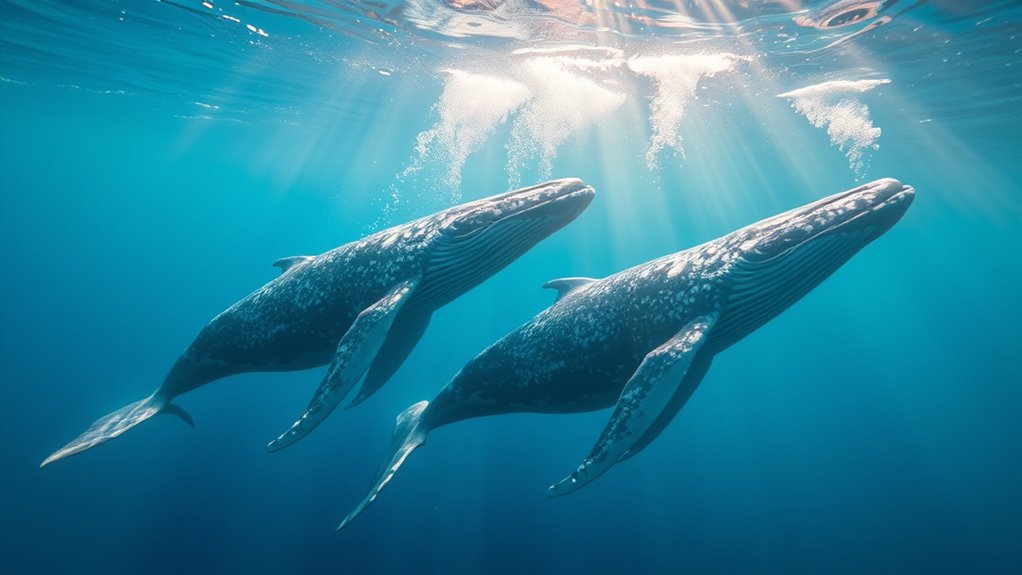Whale songs are a enchanting language of clicks, whistles, and complex melodies used for communication, navigation, and mating. Humpback whales, for example, create intricate songs lasting up to 30 minutes, showcasing their social and reproductive behaviors. Toothed whales, like orcas, employ high-frequency sounds for echolocation, while baleen whales use lower frequencies to communicate over long distances. These vocalizations play essential roles, but human activities and noise pollution disrupt their world. There's so much more to uncover about this fascinating topic.
Key Takeaways
- Humpback whale songs are complex structures lasting up to 30 minutes, used primarily for attracting mates through sexual selection.
- The songs consist of hierarchical elements like base units, phrases, and themes, showcasing cultural transmission among local whale populations.
- Humpback whales produce diverse social sounds beyond songs, including grunts and barks for communication during various interactions.
- Vocalizations evolve over time, with blue whale songs deepening in frequency since the 1960s, adapting to environmental changes.
- Noise pollution disrupts whale communication, prompting humpbacks to produce higher pitch sounds to counteract background noise interference.
Types and Purpose of Vocalization

Whale vocalizations are fascinating and varied, serving multiple crucial purposes in their underwater world. Different whale species produce a range of sounds, including clicks, whistles, and grunts. These vocalizations play critical roles in navigation, helping whales find their way through vast ocean spaces.
For instance, killer whales use long-range calls to communicate while foraging, ensuring they stay connected with their pods. Social interaction is also essential; beluga whales rely on their diverse sounds to maintain relationships within their groups.
Additionally, vocalizations can signify mating intentions, especially in humpback whales, whose intricate songs can last for hours. As these sounds evolve over time, you'll discover that each species has its unique way of expressing itself underwater.
Song of the Humpback Whale
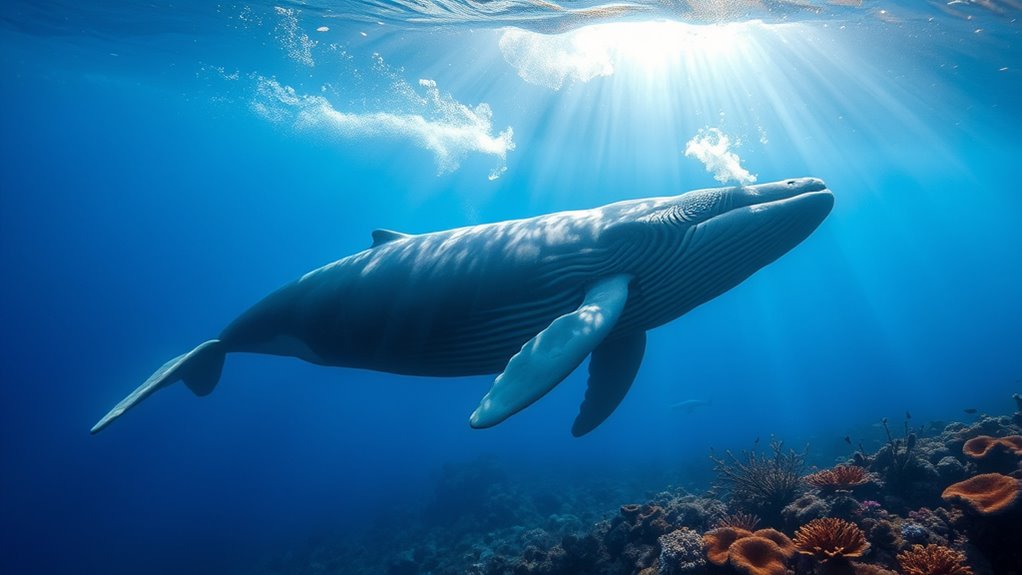
Among the various vocalizations used by marine mammals, the song of the humpback whale stands out for its complexity and beauty.
The humpback whale's song is a remarkable blend of complexity and beauty among marine mammals.
These songs can last up to 30 minutes and provide essential insights into their behavior and social interactions.
Here are some key aspects of humpback whale songs:
- Structured hierarchy: Composed of base units, sub-phrases, phrases, and themes.
- Unique combinations: No two song combinations repeat over 19 years, showcasing their evolving nature.
- Sexual selection: Primarily used to attract mates, reflecting the importance of vocalizations in courtship.
- Cultural transmission: Similar songs among whales in the same area indicate learned patterns.
- Additional sounds: Humpbacks also produce grunts, groans, and barks during social interactions.
These elements highlight the intricate communication of humpback whales.
Other Whale Sounds
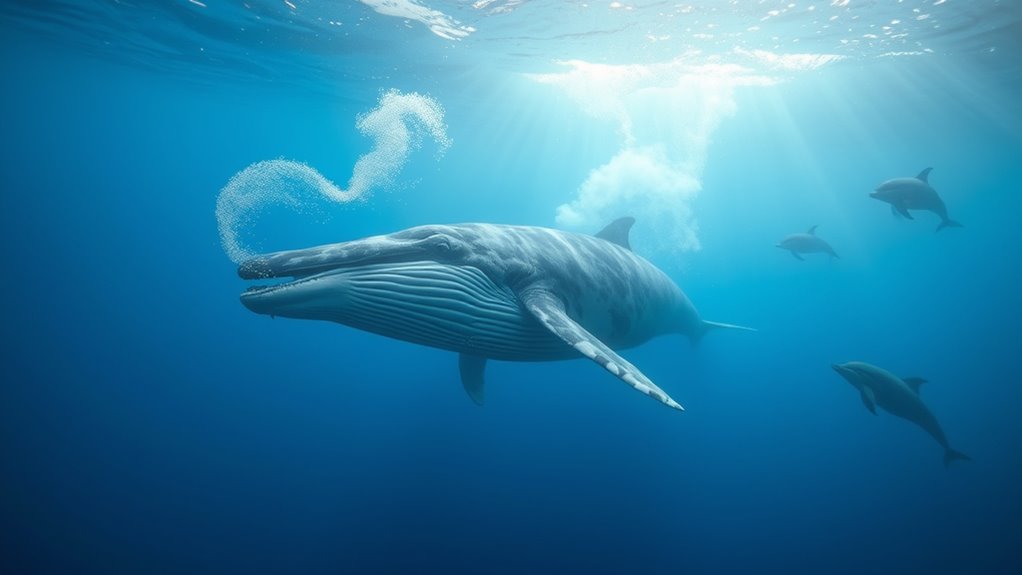
While the songs of humpback whales capture much attention, other vocalizations play a crucial role in their communication. You'll find that whales produce a variety of sounds, including grunts, groans, and barks, which are essential for social interactions.
Humpback whales also create non-song sounds during courtship, showcasing their diverse vocal repertoire. Blue whales have even adapted their tonal frequencies since the 1960s, responding to environmental changes.
Killer whales communicate using long-range calls for foraging and short-range calls during social interactions, underscoring their complex needs.
Beluga whales add richness to vocal communication with their extensive variety of whistles, clicks, and pulses, demonstrating the diversity of sounds these magnificent creatures use to connect and interact with one another.
Mechanisms of Sound Production
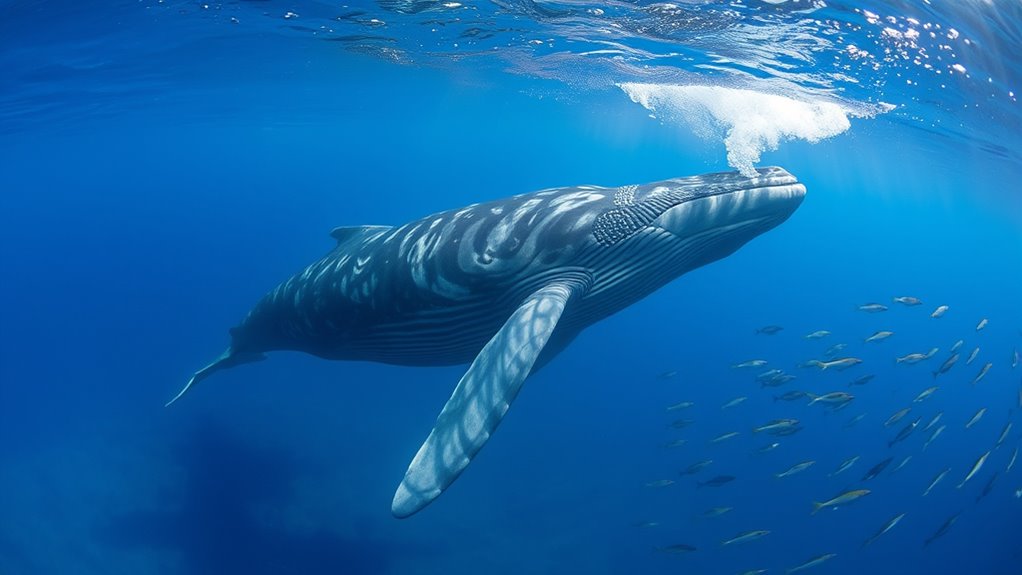
When you think about how whales communicate, it's fascinating to see the different mechanisms they use.
Toothed whales like orcas produce high-frequency clicks for echolocation, while baleen whales, such as humpbacks, create a range of sounds using their larynx.
Each method not only serves a purpose but also showcases the incredible frequency range these creatures can master.
Sound Production Differences
To understand the fascinating world of whale songs, you need to recognize the distinct mechanisms both groups of whales use to produce sound.
The sound production differences between Mysticeti and Odontoceti are striking:
- Odontoceti (toothed whales) use phonic lips, similar to human vocal cords, for quick high-frequency clicks, essential for echolocation.
- Mysticeti (baleen whales) rely on a larynx and laryngeal sac, allowing them to create low-frequency sounds without exhaling.
- Humpback whales make diverse social sounds, like grunts and groans, beyond their complex songs.
- Mysticeti can produce sounds ranging from 0.2 to 150 kHz, using lower frequencies for long-distance communication.
- Blue whale songs have significantly deepened since the 1960s, indicating evolving vocalizations over time.
Understanding these differences enriches your appreciation of their unique acoustic worlds.
Vocalization Techniques Explained
Understanding the sound production differences between Mysticeti and Odontoceti sets the stage for exploring their vocalization techniques.
Odontoceti, like dolphins and sperm whales, use specialized phonic lips to create rapid bursts of high-frequency clicks, essential for echolocation. This allows them to navigate and hunt effectively in their underwater environment.
In contrast, Mysticeti, such as humpback and blue whales, utilize a larynx and laryngeal sac to produce sounds without exhaling. Their vocalization techniques include complex songs and social sounds like grunts and groans, which can last for extended periods.
These adaptations enable both groups to communicate over vast distances, highlighting the incredible diversity in how these whales convey their messages in the ocean.
Frequency Range Usage
While exploring the frequency range usage in whale songs, you'll find that both Mysticeti and Odontoceti employ distinct mechanisms for sound production that cater to their communication needs.
- Mysticetes, like humpback whales, use their larynx and nasal cavity to create vocalizations without exhaling.
- They produce sounds ranging from 0.2 to 150 kHz, facilitating communication through grunts, groans, and complex songs.
- Lower frequencies enhance long-distance communication, while higher frequencies allow better detail discernment in the environment.
- Odontocetes, such as killer whales, utilize rapid bursts of high-frequency clicks for echolocation.
- Their vocal cords work similarly to humans, enabling precise sound production across a wide frequency range.
Understanding these mechanisms reveals how each species adapts its vocalizations to thrive in their underwater world.
Odontocete Whales
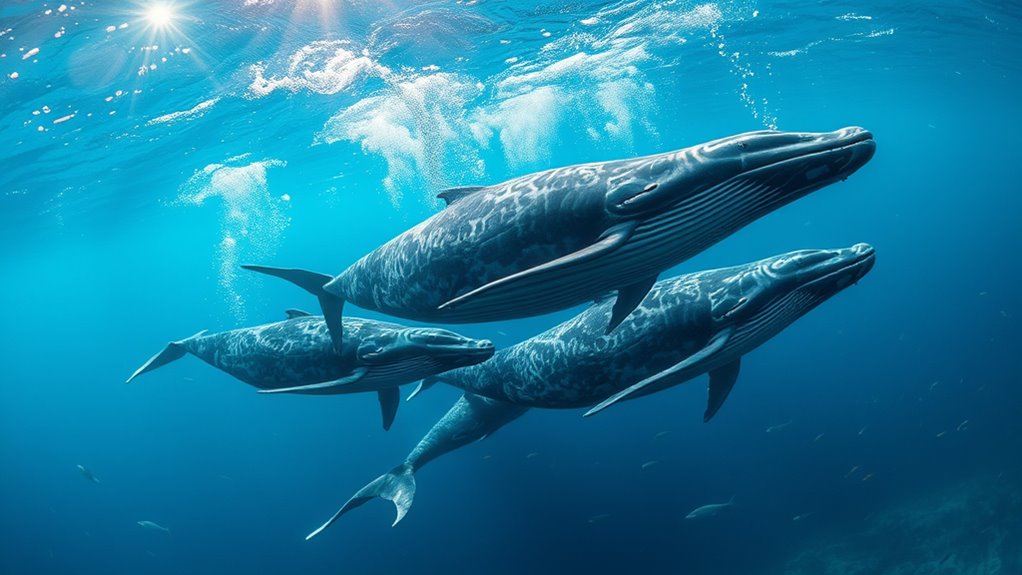
Odontocete whales, often called toothed whales, are fascinating marine mammals that use echolocation to navigate and hunt in their ocean habitats. They produce rapid bursts of high-frequency clicks, allowing them to detect objects and prey effectively.
With specialized phonic lips, these whales can create a variety of sounds, including clicks, whistles, and pulsed calls. Depending on their social context, odontocetes exhibit diverse vocalizations, from long-range calls traveling up to 16 kilometers to short-range calls for social interactions.
Remarkably, studies show that species like killer whales and belugas demonstrate behavioral flexibility in their communication, adapting their vocalizations to cope with ambient noise pollution. This ability to produce sounds across a wide frequency range enhances their interactions and survival in complex environments.
Mysticete Whales
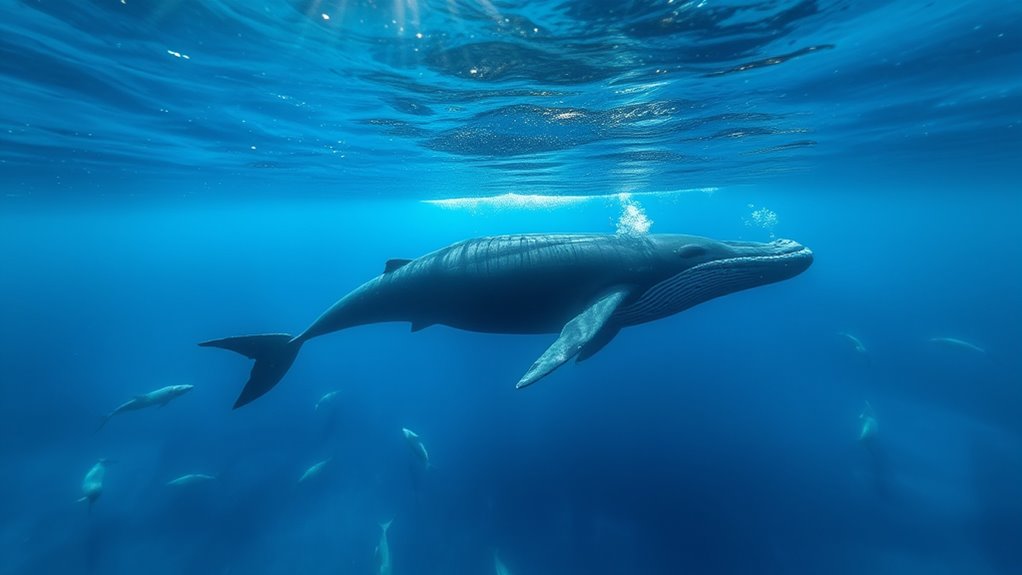
When you explore Mysticete whales, you'll notice their unique vocalization mechanisms that set them apart from other whale species.
These giants can create complex sounds without exhaling, which allows for a rich variety of communication.
However, noise pollution threatens their ability to communicate effectively, affecting their social interactions and navigation.
Vocalization Mechanisms Overview
Mysticete whales, including the majestic humpback and blue whales, have fascinating vocalization mechanisms that set them apart from their toothed relatives. They use a larynx and laryngeal sac to produce vocalizations without exhaling air, which is pretty unique.
Here's a quick overview of their vocal capabilities:
- Frequency range: 0.2 to 150 kHz, enabling diverse communication.
- Sound types: Includes clicks, buzzes, grunts, groans, and complex songs.
- Long-distance communication: Lower frequencies allow sounds to travel far.
- Evolved vocalizations: Notable changes in the blue whale's sounds since the 1960s.
- Social interactions: Humpback whales use various sounds for social bonding.
These mechanisms enhance their ability to communicate effectively across vast ocean distances.
Effects of Noise Pollution
As ambient ocean noise continues to rise, it's becoming increasingly difficult for mysticete whales to communicate effectively. Since the mid-20th century, noise pollution has increased by over 12 decibels, disrupting their ability to navigate and find mates.
You might notice that humpbacks produce higher pitch sounds in response to background noise, a phenomenon called the Lombard effect. This adjustment reflects their adaptations to a changing acoustic environment.
Research shows that blue whale songs have deepened in tonal frequency since the 1960s, indicating their struggle to maintain communication effectiveness. These vocal changes highlight how noise pollution poses challenges, leading to potential stress and reproductive difficulties for these majestic creatures as they try to thrive in a noisy ocean world.
Human Interaction
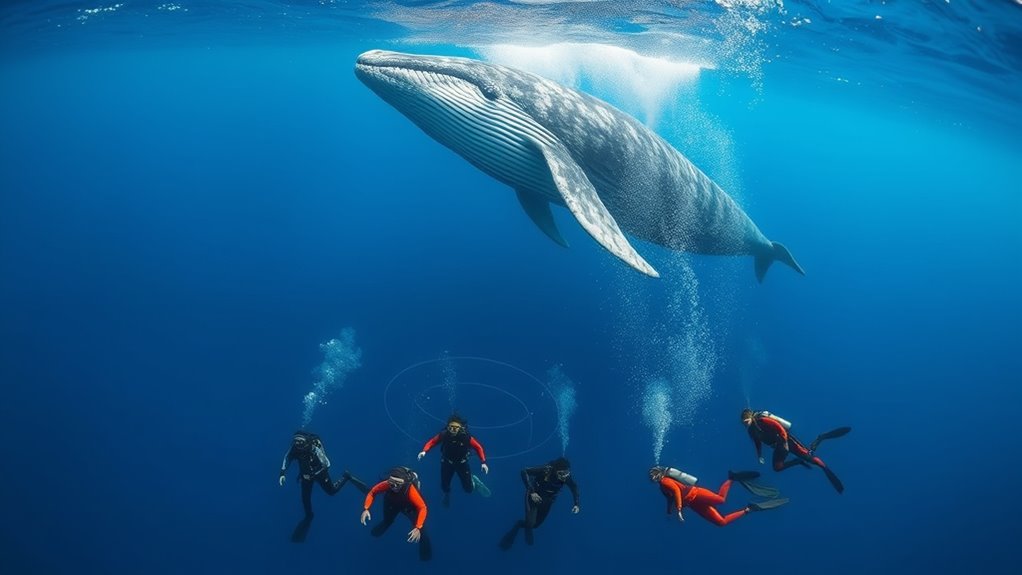
Although the ocean is a vast and seemingly untouched expanse, human activities have intrusively altered its soundscape, profoundly affecting whale communication. Increased ambient ocean noise, particularly from shipping and sonar, has disrupted their vocalizations.
Here are some key impacts of human interaction on whales:
- Ambient noise has risen over 12 decibels since the mid-20th century.
- Whales adapt their songs through the Lombard effect to be heard over the noise.
- Increased boat activity elevates stress levels and disrupts mating rituals.
- Social interactions among whales are hindered due to noise pollution.
- New technologies like signal processing aim to classify whale vocalizations amidst this interference.
Understanding these effects is crucial for preserving whale communication and protecting their habitats.
History
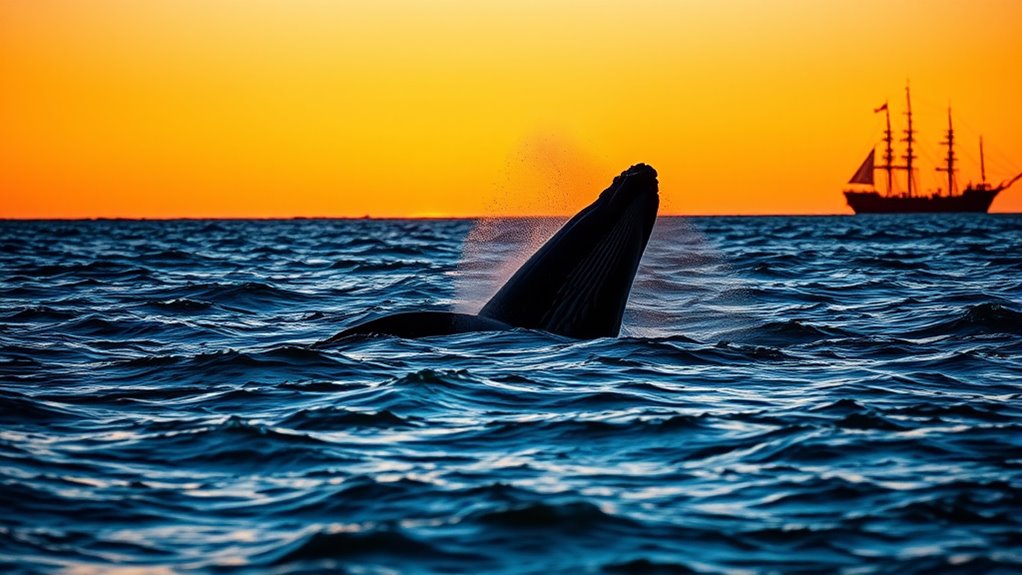
| Year | Event | Contributor |
|---|---|---|
| 1881 | First documentation of whale singing | Wm. H. Kelly |
| 1943 | First underwater recordings | William E. Schevill |
| 1970 | Release of *Songs of the Humpback Whale* | Various Artists |
| 1980s | Research on echolocation | William E. Schevill |
| 2020s | Use of machine learning | Various Researchers |
Selected Discography

The discography of whale songs showcases the remarkable diversity and evolution of these marine vocalizations over the years.
You'll find a range of influential albums that have shaped our understanding of these enchanting sounds:
- *Songs of the Humpback Whale* (1970): A pioneering collection that heightened public awareness.
- *Deep Voices: The Second Whale Record* (1977): Showcasing blue and fin whale vocalizations, emphasizing the diversity of sounds.
- Various field recordings from the 1940s: Initiated by William E. Schevill, these were essential for early research on whale phonation.
- Recent compilations utilizing machine learning: Enhancing the classification and understanding of whale vocalizations.
- Ongoing analysis of humpback whale songs: Documenting significant changes over 19 years.
These contributions illustrate the rich tapestry of whale songs and their evolving nature.
Frequently Asked Questions
What Do Whale Songs Communicate?
Whale songs communicate various messages essential for their survival and social interactions. When you listen closely, you'll hear males singing to attract females, showcasing their fitness during mating seasons.
Additionally, whales use clicks and whistles for navigation and social bonding within pods. These vocalizations help them coordinate movements and locate one another.
As you might notice, the complexity of their sounds reflects their rich social lives and adaptability to their environment.
Does Whale Song Have Structure Similar to Human Language?
When it comes to whale songs, you might say they're singing a different tune, yet they do share some structural similarities with human language.
You'll find these songs have a hierarchy, with base units building into longer phrases. While they lack grammatical rules, the way they evolve and vary by region shows a complex organization.
What Is the Meaning of the Whale Song?
The meaning of whale songs isn't fully understood, but you can see they play an essential role in communication among whales.
They may use these vocalizations to attract mates, establish social bonds, or navigate their environment. Each population has its unique song that evolves over time, suggesting a rich cultural aspect.
While scientists debate their purpose, you might wonder if whales also enjoy the beauty of their own melodies, much like humans do.
What Is the Zipf's Law in Whale Song?
Zipf's Law in whale songs showcases a fascinating frequency framework.
You'll find that certain sounds surface frequently, while others appear sparingly, just like words in human speech. This structured simplicity suggests that whales communicate with a complex, yet systematic, sound hierarchy.
By analyzing these patterns, you can glimpse the depth of their social interactions and cognitive capabilities, revealing a remarkable resemblance to the linguistic structures we use.
It's truly intriguing!
Conclusion
In the vast oceanic symphony, whale songs resonate like ancient ballads, weaving tales of the deep. Understanding these vocalizations enriches our connection to the marine world and highlights the importance of preserving their habitats. As you plunge into the mysteries of these majestic creatures, remember that their songs are not just sounds; they're the heartbeat of the ocean. By fostering a deeper appreciation for these magnificent beings, you help guarantee their melodies continue to echo through the waves.
